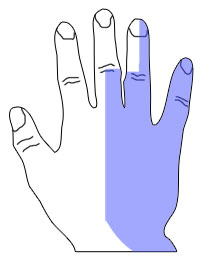Ulnar nerve
The ulnar nerve innervates most of the intrinsic muscles of the hand, and it also provides cutaneous innervation for the medial part of the hand.
A
 |
B
 |
| Figure 1. Cutaneous innervation of ulnar nerve (A) dorsal surface (B) ventral surface |
The ulnar nerve is affected in more than 27% of upper extremity nerve lesions. Most people have probably experienced the most benign form of ulnar nerve injury, which is colloquially referred to as hitting your "funny bone." This transient paresthesia actually is not caused by hitting a bone, but rather is caused by compression of the ulnar nerve at the elbow. Various conditions can arise from ulnar nerve injury, depending on whether the lesion is proximal or distal:
- Proximal lesion
- Cause
- Injury to ulnar nerve, often from fracture of medial epicondyle
- Cubital Tunnel Syndrome
- Compression of ulnar nerve as it goes under the medial epicondyle (i.e., the cubital tunnel, which is formed by a tendinous arch that joins the humeral and ulnar heads of the flexor carpi ulnaris muscle)
- Clinical presentation
- Hyperextension of ring finger and pinky at MCP joint and flexion of the same fingers at interphalangeal (PIP and DIP) joints (claw hand)
- This clinical finding makes sense because the action of the lumbricals normally is to flex digits 2-5 at the MCP joint and extend the same fingers at the interphalangeal (PIP and DIP) joints. If the lumbricals are not functional, then there will be unopposed extension at the MCP joint by the extensor muscles (extensor digitorum, extensor digiti minimi, extensor indicis) and unopposed flexion at the PIP and DIP joints by the flexor digitorum profundus muscle.
- Loss of sensation on medial side of hand
- Loss of function of most of the intrinsic muscles of hand
- When patient is asked to flex wrist, hand moves to lateral side because the flexor carpi radialis muscle is no longer opposed by the flexor carpi ulnaris muscle
- Distal lesion
- Ulnar Canal Syndrome (Guyon Tunnel Syndrome)
- Cause
- Compression of ulnar nerve as it passes through ulnar canal (Guyon tunnel), which is formed by the pisiform, hook of hamate, and pisohamate ligament
- Clinical presentation
- Loss of sensation in medial 1 ½ fingers
- Weakness of intrinsic hand muscles
- Handlebar Neuropathy
- Cause
- When cyclists rest their hands on the hand grips in an extended position for long periods of time, this puts pressure on the hook of hamate, leading to compression of the ulnar nerve.
- Clinical presentation
- Loss of sensation in medial 1 ½ fingers
- Weakness of intrinsic hand muscles



